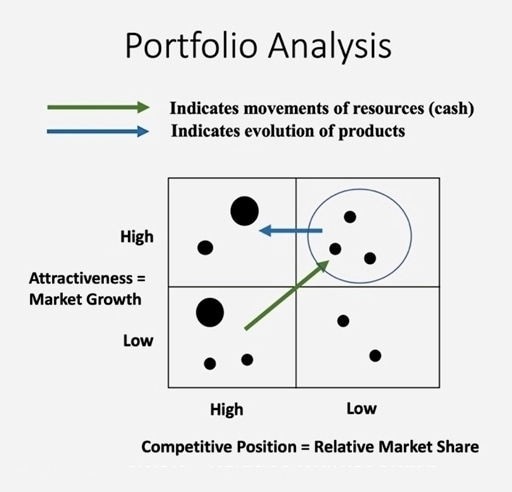One of the main questions for anyone responsible for a company's marketing strategy is how to manage multiple products (or services) for the future as well as maximize product opportunities in the present.
It turns out there are various approaches to solving that problem, which makes it a not-so-easy strategic decision. I will briefly discuss each of those in this article and highlight a few issues with each approach.
The first, which is also the most straightforward, is to continually monitor market trends. That is, keep track of and record market trends and customer feedback to ensure that your portfolio's products align with the latest trends and customer demands.
That sounds easy, but it takes a lot of time and resources to stay up on market trends, especially if they are always in flux. Also, obtaining and analyzing reliable data from various sources can be challenging.
A second approach relies on segmenting the market by benefits. When you take that approach, it becomes easy to differentiate your products by market segment (or descriptors of who is in each segment). That way, you will gain clarity on how the entire portfolio of products fits together. This approach will also allow you to assess the size and growth of each segment, giving you a longer-term view of managing your different products.
Unfortunately, however, most B2B companies instead rely on vertical marketing, the idea of which is to offer products and services specialized for customers in a particular industry or vertical—which is not really segmenting a market. Thus, such vertical or category approaches to segmentation won't give you the perspective necessary for a straightforward approach to managing a portfolio of products.
A third approach relies on product life cycle management. In a previous article, I talked about classic product life cycles. That is, you regularly examine your product portfolio and manage the product life cycle of each product to see whether they need updates, changes, or new releases.
So, imagine each of your products on a whiteboard with its own product life cycle depicted. Some of your products will be at the introduction stage, others at a more mature stage. You can readily see how those different products need to be managed differently.
Among the few problems with this approach is that not all products follow the same life cycle: Although the product life cycle model helps measure the performance of individual products, it may not accurately capture the life cycle of every product a company sells. Some products may have longer or shorter life cycles or may experience unexpected spikes in demand that do not fit neatly within the life cycle stages.
Also, focusing solely on the product life cycle can lead to a misalignment with broader business strategy, such as diversifying product lines or entering new markets. Companies should be considering the role of each product within the broader context of their business goals and strategy.
A fourth approach is to classify the different products by priority: Prioritize the products based on business goals and revenue potential and understand which products will significantly impact the market.
The problem with this method is that by focusing solely on the priority level assigned to a particular product, you may overlook other important factors, such as customer preferences and market trends. Also, this method may not allow for changes in priority levels based on shifts in the market, consumer preferences, or other external factors. Finally, by focusing solely on high-priority products, a company may miss out on potential revenue from lower-priority items that still have market demand.
A fifth perspective, and an approach I favor, manages a group of products/services together as part of a portfolio. The emphasis here is on business synergies: A company is thought of as a collection of related businesses.
This approach explicitly recognizes differential resource requirements: Some products need resources, while others provide resources. In this view, you can develop a product road map to ensure that the product development process is streamlined and aligned with business goals.
The methodology of this perspective is to simultaneously analyze all products in terms of market attractiveness and competitive position. A visual representation of this approach is presented below.
Essentially, you place all your products and services into a 2 x 2 matrix based on attractiveness (or market growth potential) and competitive position (or relative market share). Make the size of each product (the circle) larger or smaller to represent the relative revenue contribution of that product to your company.

Once you create this portfolio approach, you can readily see how to evolve products (from low market share in high-growth markets to high market share) and resource deployment (moving cash from low-growth but high market-share products). This approach mirrors the classic Boston Consulting Group matrix, where products with high market share but low growth represent the classic "cash cow."
Of course, the problem with this approach is how to determine with precision the dividing line between high growth and low growth, and exactly where market share shifts from high to low.
Nonetheless, by creating a product portfolio management system, you make it easier to effectively manage multiple products simultaneously while ensuring that each product contributes to your business growth.
* * *
In sum: all approaches to managing multiple products have downsides, but it's important to choose one and really understand the benefits and risks of that approach. That way you'll be able to effectively manage not only your various products but also the risks that inevitably arise.




